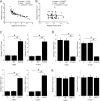LncRNA PLAC 2 downregulated miR-21 in non-small cell lung cancer and predicted survival
- PMID: 31500623
- PMCID: PMC6734259
- DOI: 10.1186/s12890-019-0931-6
LncRNA PLAC 2 downregulated miR-21 in non-small cell lung cancer and predicted survival
Abstract
Background: LncRNA PLAC2 has been characterized as a tumor suppressive lncRNA in glioma. We investigated the role of PLAC2 in non-small cell lung cancer (NSCLC).
Methods: A total of 187 NSCLC patients were admitted by The First Hospital of Jilin University from December 2010 to December 2014. All the patients were diagnosed by histopathological approaches. Transient cell transfections, RT-qPCR, invasion, and migration ability measurement, were applied for the experiments.
Results: PLAC2 was down-regulated, while miR-21 was up-regulated in NSCLC tissues compared to non-cancer tissues. Low PLAC2 levels in NSCLC tissues were associated with poor survival of NSCLC patients. PLAC2 and miR-21 were inversely correlated, and PLAC 2 over-expression in NSCLC cells resulted in the down-regulation of miR-21. However, miR-21 over-expression did not significantly affect PLAC2 expression. In addition, PLAC2 over-expression resulted in decreased migration and invasion rates of NSCLC cells. MiR-21 over-expression played the opposite role and attenuated the effects of PLAC2 over-expression.
Conclusions: In conclusion, lncRNA PLAC2 down-regulated miR-21 in NSCLC and inhibited cancer cell migration and invasion.
Keywords: Non-small cell lung cancer; Survival; lncRNA PLAC2; miR-21.
Conflict of interest statement
The authors declare that they have no competing interests.
Figures





Similar articles
-
IncRNA PLAC2 Upregulates CDK6 by Directly Targeting miR-29C to Promote Cell Proliferation in Lung Squamous Cell Carcinoma.Crit Rev Eukaryot Gene Expr. 2022;32(8):55-67. doi: 10.1615/CritRevEukaryotGeneExpr.2022044134. Crit Rev Eukaryot Gene Expr. 2022. PMID: 36017916
-
LncRNA PLAC2 upregulates miR-663 to downregulate TGF-β1 and suppress bladder cancer cell migration and invasion.BMC Urol. 2020 Jul 10;20(1):94. doi: 10.1186/s12894-020-00663-w. BMC Urol. 2020. PMID: 32650766 Free PMC article.
-
Long noncoding RNA POU3F3 enhances cancer cell proliferation, migration and invasion in non-small cell lung cancer (adenocarcinoma) by downregulating microRNA-30d-5p.BMC Pulm Med. 2020 Jul 2;20(1):185. doi: 10.1186/s12890-020-01218-3. BMC Pulm Med. 2020. PMID: 32615948 Free PMC article.
-
LncRNA FEZF1-AS1 promotes non-small lung cancer cell migration and invasion through the up-regulation of NOTCH1 by serving as a sponge of miR-34a.BMC Pulm Med. 2020 Apr 29;20(1):110. doi: 10.1186/s12890-020-1154-6. BMC Pulm Med. 2020. PMID: 32349744 Free PMC article.
-
LncRNA SNHG10 is downregulated in non-small cell lung cancer and predicts poor survival.BMC Pulm Med. 2020 Oct 20;20(1):273. doi: 10.1186/s12890-020-01281-w. BMC Pulm Med. 2020. PMID: 33081752 Free PMC article.
Cited by
-
MicroRNA‑21: A potential therapeutic target in lung cancer (Review).Int J Oncol. 2025 Aug;67(2):67. doi: 10.3892/ijo.2025.5773. Epub 2025 Jul 11. Int J Oncol. 2025. PMID: 40641110 Free PMC article. Review.
-
LINC00184 plays an oncogenic role in non-small cell lung cancer via regulation of the miR-524-5p/HMGB2 axis.J Cell Mol Med. 2021 Nov;25(21):9927-9938. doi: 10.1111/jcmm.16247. Epub 2021 Oct 15. J Cell Mol Med. 2021. PMID: 34651416 Free PMC article.
-
microRNA 21 and long non-coding RNAs interplays underlie cancer pathophysiology: A narrative review.Noncoding RNA Res. 2024 Mar 31;9(3):831-852. doi: 10.1016/j.ncrna.2024.03.013. eCollection 2024 Sep. Noncoding RNA Res. 2024. PMID: 38586315 Free PMC article. Review.
-
TINCR: An lncRNA with dual functions in the carcinogenesis process.Noncoding RNA Res. 2020 Jul 9;5(3):109-115. doi: 10.1016/j.ncrna.2020.06.003. eCollection 2020 Sep. Noncoding RNA Res. 2020. PMID: 32695943 Free PMC article.
-
The Common miRNAs between Tuberculosis and Non-Small Cell Lung Cancer: A Critical Review.Tanaffos. 2021 Mar;20(3):197-208. Tanaffos. 2021. PMID: 35382078 Free PMC article. Review.
References
MeSH terms
Substances
LinkOut - more resources
Full Text Sources
Medical

